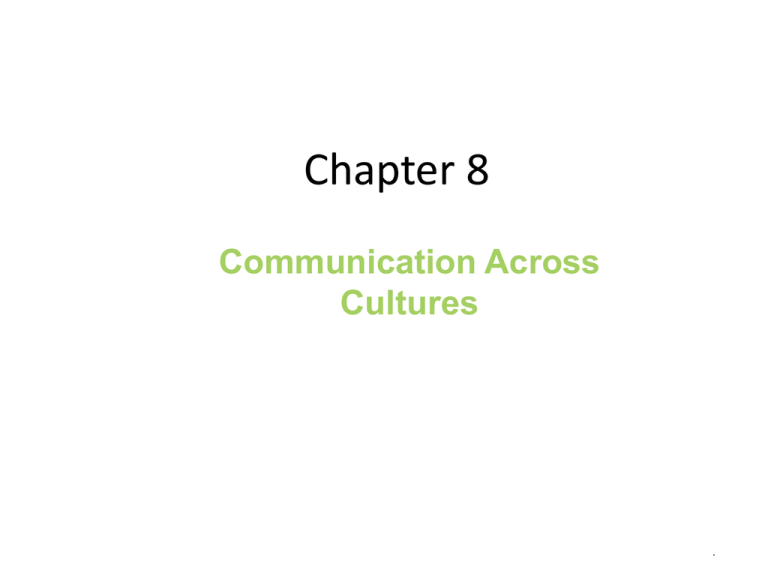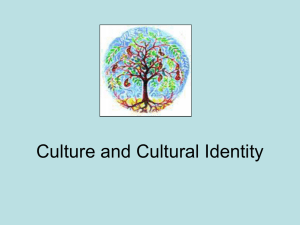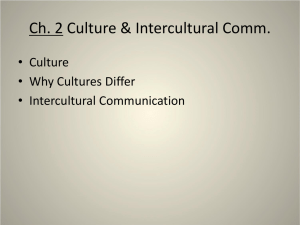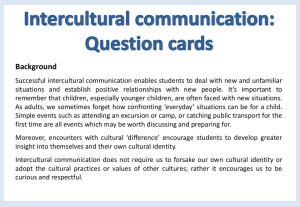Chapter 8
advertisement

Chapter 8 Communication Across Cultures . What is Culture? • High Culture – Culture of the elite class – i.e. Opera, ballet, literature • Low Culture – Culture of the working class – i.e. Folk art, popular theater • Popular Culture – Culture of common everyday people – i.e. TV, magazine, movies, fashion, music Anthropologic Definition • Culture is passed down from generation to generation through symbols . • Culture allows us to make sense and understand the world. • Culture allows us to express ourselves. • When you share the system of meaning, you become part of the culture. Culture as a Site of Contested Meaning Cultural Studies Definition • Culture is not shared by everyone, but contested and negotiated. • Focus on representations of class, race, gender, sexuality, and nationality in the media. • Culture as an apparatus of power, system of domination. • Culture is a site where power relations are negotiated. • Hegemony : Domination through consent Culture as a Resource Globalization Definition • Culture is used as resource for economic growth in global trade (movies, music, etc.) • Resource for political movement. • Resource for educating people: literacy, health campaigns, etc. • Resource for collective resistance and social change Cultural Identity • A situated sense of self that is shaped by our cultural experiences and social locations • How do you define yourself in terms of cultural identity? – Do you have multiple cultural identities? • How does your cultural identity shape your perspectives, beliefs and relationships with others? • Is the way you identify culturally related to issues of power? – For example, dominant groups identities are often not as salient as non-dominant group identities Positionality • A term that describes how we are socially positioned in relation to each other. • One’s social location shaped by differences--race, class, gender, sexual orientation, religion, nationality, and physical abilities – i.e. I’m a woman, of Mexican descent, upper class, and deaf – i.e. I’m a White American male who is in a committed relationship with another man, educated, from working class, and non-religious Standpoint Theory • Standpoint: A place from which to view and make sense of the world. • Your positionality gives you a particular standpoint. • Different realities depending on the position from which to view it. • People with less power in society often have a fuller and more comprehensive view—both the dominant and marginalized view. Standpoint Theory and Positionality • We may see, experience, and understand the world quite differently based on our different standpoints and positionalities . • Knowledge about ourselves and others is situated and partial. • Knowledge is always and inevitably connected to power. • Oppositional standpoints can be formed to challenge and contest the status quo. Ethnocentrism • Ethno: group or nation • Kentron: center • Idea that one’s own group’s way of thinking, being and acting is superior to others. • Ethnocentrism can result in dehumanization, prejudices, discrimination, conflict, and violence. Communication 440 Panama 2012 • • • • The importance of intercultural communication What is intercultural communication? Intercultural communication and the individual The individual, intercultural communication, and society • Ethics and intercultural communication • Improving your intercultural communication skills • We have increased opportunities for intercultural contact due to – Relocation of peoples • Diaspora – displacement because of untenable conditions – Increasing cultural diversity within the U.S. – The Internet • Studying intercultural communication can lead to greater success in domestic and international business • International business failure occurs often as a result of poor intercultural planning • We need better communication between countries and ethnic groups • Conflicts may require mediation (peaceful third-party intervention) • Studying intercultural communication can make us more aware of our own cultural identity and communication patterns • Occurs in interactions with people who are culturally different Culture is dynamic, heterogeneous (diverse), and operates within societal power structures • One can become a border dweller (one who lives between cultures) through – Travel – Socialization (cocultural groups) – Participation in an intercultural relationship • Border dwelling can be voluntary or involuntary, for short or long periods Culture shock - disorientation or discomfort with new surroundings Reverse cultural shock – culture shock in one’s home culture Cultural values = are central beliefs of cultural groups that prescribe what should be; these strongly influence individual behavior in interaction – Individualism – cultural emphasis on individual autonomy/independence – Collectivism – cultural emphasis on needs of the group • Preferred personality refers to a culture’s emphasis on whether it is more important to “do” or to “be” – “Doing” mode – working hard to achieve material gain – “Being” mode - experiencing life and relationships with others • Another value difference is the view of human nature as essentially good or evil • Another value difference is the human-nature value orientation, which is the perceived relationship between humans and nature – Some cultures believe humans are intended to rule nature – Others believe nature rules humans – Still others believe humans and nature exist in harmony • Power distance refers to the extent to which less powerful members of organizations within a culture accept unequal distribution of power – Some cultures embrace the minimization of inequality and an emphasis on informality regardless of rank – Some cultures are structured around formal hierarchies with clear roles • Long-term v. short-term orientations reflect a culture’s attitude toward virtue and truth – Short-term emphasize one fundamental truth (monotheism) – Long-term respect polytheistic ideas of thrift, perseverance, and a willingness to subordinate oneself to a purpose • One that emphasizes simultaneous contradictory truths – Challenges dichotomous (either/or) thinking • Cultural/individual dialectic - some behaviors determined by culture, others are idiosyncratic • Personal/contextual dialectic - the individual and the situation are both important in intercultural communication • Differences/similarities dialectic - disjunctures and commonalities between cultures can both be present • Something can be one thing and its opposite at the same time • Static/dynamic dialectic - some cultural patterns stable, but can change • History/Past-Present/Future dialectic - emphasizes both the present and the past influences on a culture • Privilege-disadvantage dialectic - cultural members can be privileged and disadvantaged Broad political and historical forces have the power to influence Perceptions Understanding Communication patterns of contemporary intercultural interactions on all relationship levels • Those with less power in a culture tend to notice influential power differences – Power determines whose cultural values will be respected and followed – Significant minority groups within a dominant majority have to decide how they will relate to individuals in a dominant culture • Remember that everyone is enmeshed in a culture and is communicating through a particular cultural lens • Be aware of the humanity of other cultural groups and avoid viewing them as an exotic “other” • Be open to alternate ways of viewing the world than the ones you were taught • Increase your motivation to be an effective communicator • Increase your knowledge of your own culture and the history, background, and values of other cultures • Avoid stereotypes and prejudices of individuals from cultural groups other than your own, even if these appear to be complimentary in nature






